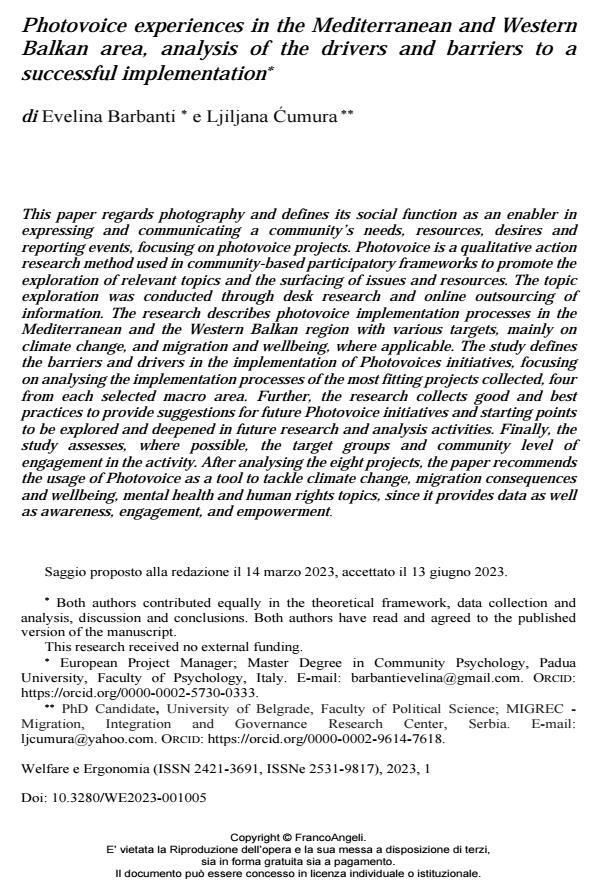Photovoice experiences in the Mediterranean and Western Balkan area, analysis of the drivers and barriers to a successful implementation
Titolo Rivista WELFARE E ERGONOMIA
Autori/Curatori Evelina Barbanti, Ljiljana Cumura
Anno di pubblicazione 2023 Fascicolo 2023/1
Lingua Inglese Numero pagine 16 P. 59-74 Dimensione file 350 KB
DOI 10.3280/WE2023-001005
Il DOI è il codice a barre della proprietà intellettuale: per saperne di più
clicca qui
Qui sotto puoi vedere in anteprima la prima pagina di questo articolo.
Se questo articolo ti interessa, lo puoi acquistare (e scaricare in formato pdf) seguendo le facili indicazioni per acquistare il download credit. Acquista Download Credits per scaricare questo Articolo in formato PDF

FrancoAngeli è membro della Publishers International Linking Association, Inc (PILA)associazione indipendente e non profit per facilitare (attraverso i servizi tecnologici implementati da CrossRef.org) l’accesso degli studiosi ai contenuti digitali nelle pubblicazioni professionali e scientifiche
This paper regards photography and defines its social function as an enabler in expressing and communicating a community’s needs, resources, desires and reporting events, focusing on photovoice projects. Photovoice is a qualitative action research method used in community-based participatory frameworks to promote the exploration of relevant topics and the surfacing of issues and resources. The topic exploration was conducted through desk research and online outsourcing of information. The research describes photovoice implementation processes in the Mediterranean and the Western Balkan region with various targets, mainly on climate change, and migration and wellbeing, where applicable. The study defines the barriers and drivers in the implementation of Photovoices initiatives, focusing on analysing the implementation processes of the most fitting projects collected, four from each selected macro area. Further, the research collects good and best practices to provide suggestions for future Photovoice initiatives and starting points to be explored and deepened in future research and analysis activities. Finally, the study assesses, where possible, the target groups and community level of engagement in the activity. After analysing the eight projects, the paper recommends the usage of Photovoice as a tool to tackle climate change, migration consequences and wellbeing, mental health and human rights topics, since it provides data as well as awareness, engagement, and empowerment.
L’elaborato riguarda la fotografia e ne definisce la funzione sociale, in qualità di strumento abilitante all’espressione e comunicazione delle necessità, delle risorse e dei desideri di una comunità, presentando progetti Photovoice. Photovoice è una metodologia di ricerca azione utilizzata in framework teorici partecipativi e basati sulla comunità stessa, atta alla promozione dell’esplorazione di tematiche rilevanti e all'emersione di problematiche e risorse riguardo le stesse. L’esplorazione dei temi sarà condotta raccogliendo dati tramite ricerca documentale ed online. La ricerca descrive i processi di implementazione della tecnica Photovoice, nelle aree geografiche del Mediterraneo e dei Balcani con varie tipologie di partecipanti riguardanti principalmente il fenomeno del cambiamento climatico, migrazione e benessere. Lo studio definisce fattori ostativi e trainanti all’implementazione della tecnica Photovoice focalizzandosi sull’analisi dei progetti raccolti, di uno per macroarea identificata. Lo studio raccoglierà buone pratiche nell’implementazione di Photovoice con l’obiettivo di dare suggerimenti a futuri progetti ed indicazione riguardo tematiche da approfondire tramite future ricerche. Infine la ricerca discuterà i target di partecipanti coinvolti ed il livello di ingaggio della community. In seguito all’analisi degli otto progetti, l’articolo raccomanda l’uso di Photovoice come strumento per affrontare le conseguenze del cambiamento climatico, delle migrazioni, benessere, salute mentale e diritti umani poiché procura dati, consapevolezza, ingaggio ed empowerment riguardo i temi trattati.
Parole chiave:Photovoice; Impatto sociale; Fotografia; Community; Ricerca azione; Ricerca documentale.
Evelina Barbanti, Ljiljana Cumura, Photovoice experiences in the Mediterranean and Western Balkan area, analysis of the drivers and barriers to a successful implementation in "WELFARE E ERGONOMIA" 1/2023, pp 59-74, DOI: 10.3280/WE2023-001005